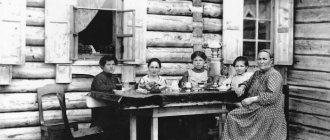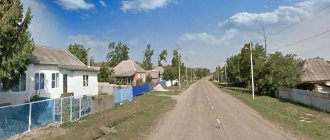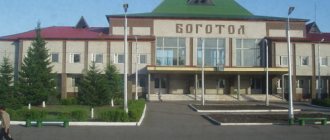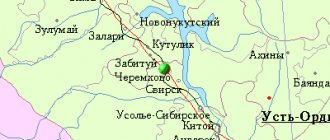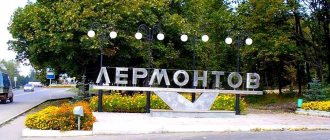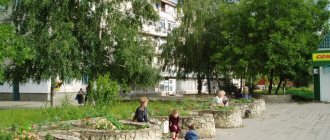Story
Taishet owes its appearance to the Trans-Siberian Railway. During its construction, in the spring of 1897, a small settlement was founded, where in the fall of the same year, with the beginning of railway traffic, a station was opened, and in 1904 a locomotive depot was built.
At the station there was a one-class school, a medical and nutritional center of the Resettlement Administration. The peasant settlers who arrived here successfully developed the nearby lands, and soon agricultural and timber cargo began to leave the station.
The convenient location in the valley of the Biryusa River (navigable at that time), as well as the proximity of the railway, contributed to the rapid development of the new settlement. In 1906 it was transformed into a village, which in 1910 became the administrative center of the Taishet volost.
During the period of collectivization, Taishet was chosen as a place of kulak exile. In its vicinity, special settlements were created for dispossessed and exiled peasants. The flow of exiles began to grow after the decision of the Politburo of the All-Union Communist Party of Bolsheviks on the construction of the BAM in 1932.
In 1937, the village of Taishet was transformed into a workers' settlement, which immediately became a regional center in the Irkutsk region created in the same year.
In March 1938, the village received city status. At that time, there were two large sawmills, a sleeper impregnation plant, a locomotive depot and a car repair point, a brick factory, a machine and tractor workshop, a steam mill and two bakeries.
Since 1938, a number of Gulag units were stationed in Taishet, and it turned into a kind of “camp capital” of the Irkutsk region. The Western section of the BAM began here. Along the route of the future railway, camps and columns of forced labor camps (ITL) were placed. This dark period in the city's history lasted until almost the 1960s. During this period the following were stationed in Taishet:
— Taishetlag (ITL UNKVD in the Irkutsk region);
- Yuzhlag (ITL GULZhDS NKVD);
— Ozerlag (ITL No. 7 with a particularly strict regime for keeping prisoners, created in 1948-1949 on the basis of Yuzhlag).
Using the free labor of prisoners, the authorities hoped to quickly build the highway. It was planned to open train traffic on the Taishet-Padun section (350 km) in 1940, and on the Padun-Lena section in 1941. But these plans were never implemented. Partly due to the poor organization of work, their poor engineering training and high costs, but mainly due to the extremely ineffective labor of prisoners. It turned out that railway construction carried out by the GULAG system is significantly inferior in efficiency to the work on the construction of the Trans-Siberian Railway and other highways in pre-revolutionary Russia.
Suffice it to say that from 1932 (from the decision to build the BAM) until the start of the Great Patriotic War, only 124 km of the route (from Taishet to Chuna) were prepared, while the roadbed was filled and engineering structures were built only on a section of 76 km, and the rails were laid for 58 km. (For comparison, let us recall that in pre-revolutionary Russia, up to 2 thousand km of railway lines were built annually. This figure turned out to be unattainable in Soviet times, despite the titanic efforts of the authorities and the gigantic sacrifices of the Gulag period.)
With the outbreak of the war, the construction of the BAM was stopped. The laid railway track was dismantled, and the rails were sent to the European part of the country for defense purposes. The main contingent of the Yuzhlag, together with car repair shops, was transferred to the front-line areas and used to repair equipment. Many were sent to penal battalions; the remaining prisoners in Taishet were transferred to logging and agricultural work.
After the war, the People's Commissariat of Railways proposed to the Council of People's Commissars of the USSR to resume the construction of the highway, using not only prisoners, but also prisoners of war for work. In the fall of 1945, in addition to Taishetlag and Yuzhlag, Angarlag was created (to work on the section of the highway from Bratsk to Ust-Kut).
Construction began simultaneously in several places on the future highway. Due to the high mortality rate, the camps were constantly replenished with new batches of prisoners and prisoners of war (39 thousand Japanese prisoners of war alone arrived at the end of 1945). But work continued to proceed slowly, and in October 1948 the Taishet ITL was liquidated, creating on its basis a special camp No. 7 - Ozerlag - with a stricter regime. At the same time, the number of prisoners was increased.
At the end of the 1940s. In two ITLs, about 100 thousand people were gathered for construction work. (in Angarlag - about 60 thousand, in Ozerlag - 40 thousand). This is almost twice as much as was used in the construction of the Trans-Siberian Railway at the end of the 19th century. But even such a mass of free labor could not compensate for the extremely low organizational and engineering support for construction work. To some extent, the situation was saved by the “Harbin people” - our compatriots living in Manchuria, who after the defeat of the Kwantung Army in the fall of 1945 found themselves “enemies of the people” and exiled to build the road. Many of them had extensive experience in railway construction (participated in the construction of the Trans-Siberian Railway and the Chinese Eastern Railway) and remained to work in Harbin after the revolution. The “Harbinites” stood out among other prisoners for their hard work and professionalism. Thanks to their participation, the construction of the highway went faster.
In December 1947, the railway line was laid to old Bratsk, where the first train arrived with four heated cars. This section was put into operation in the summer of 1951, after the opening of traffic on the new railway bridge across the Angara. And only in January 1959, a meeting was held in the village of Zayarsk dedicated to the commissioning of the entire Taishet-Lena highway for permanent operation.
With the help of prisoners, a number of residential buildings were built in the city (on Pushkin, Kirov, Kooperativnaya, Frunze streets, etc.), as well as some social and cultural facilities (a hospital, a hotel, a canteen, a bathhouse, several kindergartens, shops, barracks). Much of what was built during that period is still in use today.
Large human losses during the construction of the road, as well as the low efficiency of prisoners’ labor, led to the decision to postpone the construction of the BAM on the section from Lena to Amur. They returned to the implementation of this large-scale project only in 1974, declaring the BAM a shock All-Union Komsomol construction site. At that time, Taishet again became a stronghold and transit city for new railway construction.
On the eve of the crisis of the 1990s. In Taishet, a construction industry plant, an automobile repair and sleep impregnation plant, a garment factory, a meat processing plant, a food processing plant, a butter factory, a bakery, etc. were successfully operating and increasing their production volumes. Few of these once successful enterprises have survived. A construction industry plant, a garment factory, a meat processing plant, a bakery and a number of other enterprises ceased to exist.
Vinokurov M.A., Sukhodolov A.P. Cities of the Irkutsk region
Taishet fell into the flood zone that occurred at the end of June 2022. According to the press service of the government of the Irkutsk region, 53 houses were flooded in Taishet1.
Read on Irkipedia
- Political exile, revolutionary events and the Civil War in the Taishet region
- Taishet before 1917
- Taishet // “Historical Encyclopedia of Siberia” (2009)
- Taishetlag
- Who carried BAM on their shoulders
- Railway Abakan - Taishet. History of construction
- Taishet City Komsomol Committee (Gorkom) (1960–1991)
- Taishet City Party Committee (Gorkom) (1960–1991)
Our history. City on the four winds
In the old days, when the country was different, Taishet and the Taishet district were different, and the journalists were not the same as today, our region appeared quite often on the pages of regional and central media. And not in connection with incidents and other bad events, as is happening today, but in the context of our achievements and movement towards development. But in 1996, when East Siberian Pravda correspondent Evgeny Bogachev visited Taishet, things were going very poorly for us. Much worse than today. An article in VSP for April 6, 1996 is about this. Let's remember how it was.
Evgeny BOGACHEV, “East Siberian Truth” Photo by Valery KARNAUKHOV
The Siberian cities born of the Trans-Siberian Railway have their own special stamp. Over the course of a century, no matter how hard they try to try on other outfits, their “railway” equipment gives them away.
And they most often built up along and on both sides of the railway, so that they could look out of all the windows day and night at their steel nurse.
Such is Taishet.
The local station is a noisy, colorful, bustling sight. Even in the sleepy pre-dawn hours, he lives with the worries and sufferings of road wanderers. And in the motley crowd of people, absorbed and squeezed out by the next passenger train, there are more and more peddlers-baggers, seekers of work, bread or simply adventure. This is the reality. Each time has its own passengers.
Taishet24 on Odnoklassniki
The difference between Taishet and other large stations is significant. He is destined by fate and the development of Russian history to stand at the intersection of four directions, or, as the Taishetians themselves say, on the four winds. This detail largely determines the local way of life. Taishet has turned into a transit point for all kinds of goods, including drugs, and into a small Siberian Rome, because all roads now lead here.
And the city is mainly held in the pocket of the Taishet branch of the East Siberian Railway. It is from this pocket that two-thirds of the city treasury is replenished. The “nurse”, without getting tired, continues to lay golden eggs, although she herself is increasingly content with bartering from second-rate goods. There’s nothing to be done, the insolvent shipper drove her into such realities today.
Most of the other Taishet industries, born of the construction of railways to the south and north, not to mention the Trans-Siberian Railway, are withering away along with their parents abandoned to the mercy of fate.
The construction industry plant, built under the once-loud title of BAM, is dragging out a miserable existence. But thanks to him, Taishet found a second wind - microdistricts of large-panel high-rise buildings noticeably beautified the provincial wooden town and added more residents to it.
The plant for the repair of road-building machines also withered away. Here the years of labor glory and red banners are remembered with sadness. He was known far beyond the region for his ultra-precision machine tools, his foundry and, of course, his products. Having turned from a “numbered” into a mediocre farm, having passed from hand to hand, today no one needs it. The personnel - the pride of the plant - have left: some to retire, some to search for a better life.
Attempts to save the plant, according to the mayor of the city Anatoly Strelkov , have so far been unsuccessful. “Relieve us of ballast,” the director asked, handing over the factory’s social and cultural services, and then housing, to the city authorities. Incurring large expenses for their maintenance, the mayor's office did not wait for either the plant's recovery or the promised revenues from it to the city treasury. To resuscitate the ZRDSM, at least tens of billions of rubles are needed. Where can I get them?
Geography
Taishet is located in the right-bank valley of the Biryusa River, between its small right tributaries - Taishetka and Akulshetka. Surrounded by forests. In the surrounding area there are plots of land developed for agricultural activities. There are wetlands in the floodplains of nearby rivers. To the south of Taishet, the hilly hills of the spurs of the Sayan mountain range begin. The city itself is located within the Taishet foothill plain at an altitude of 302 m above sea level.
Topographic map of square N-47-A (Alzamay, Taishet, Biryusa River)
Transport accessibility
The city is located in the western part of the region, 680 km from the regional center - Irkutsk. In Tayshet there is a railway junction and a large out-of-class marshalling station, where highways of four directions converge. The Trans-Siberian Railway runs from west to east, the Baikal-Amur Mainline begins from Taishet (the first kilometer of the Baikal-Amur Mainline is in Taishet), and a railway line departs in a southern direction connecting the city with the capital of Khakassia, Abakan, and with Kuzbass. The federal highway P255 “Siberia” passes in close proximity to the city. Taishet is the starting point for the construction of the Eastern Siberia-Pacific Ocean (ESPO) oil pipeline.
Map
| Taishet: maps |
Taishet: photo from space (Google Maps) Taishet: photo from space (Microsoft Virtual Earth)
| Taishet. Nearest cities. Distances in km. on the map (in brackets along roads) + direction. Using the hyperlink in the distance , you can get the route (information courtesy of the AutoTransInfo website) | |||
| 1 | Biryusinsk | 12 (9) | Z |
| 2 | Yurts | 26 (31) | NW |
| 3 | Lower Poima (Krasnoyarsk Territory) | 56 (61) | NW |
| 4 | Alzamay | 58 (67) | SE |
| 5 | Lesogorsk | 95 () | IN |
| 6 | Nizhny Ingash (Krasnoyarsk region) | 96 (111) | Z |
| 7 | Chunsky | 102 (121) | IN |
| 8 | Ilansky | 125 (139) | Z |
| 9 | Nizhneudinsk | 131 (157) | SE |
| 10 | Aban (Krasnoyarsk region) | 145 (219) | NW |
| 11 | Kansk | 146 (161) | Z |
| 12 | Irbeyskoye (Krasnoyarsk region) | 163 (251) | Z |
| 13 | Oktyabrsky (Krasnoyarsk region) | 170 () | WITH |
| 14 | Borodino | 194 (234) | Z |
a brief description of
Located in the southwestern part of the Biryusinsky plateau, on the river. Biryusa. Railway junction lines and highways.
Territory (sq. km): 49
Information about the city of Taishet on the Russian Wikipedia site
Historical sketch
It emerged in 1897 as a small village of Taishet; name by location on the river Taishet (right tributary of the Biryusa). Hydronym from Ket ta “cold”, shet “river”.
The convenient location on the railway, near a large river, determined the role of Taishet as an administrative and commercial center. City since 1938
Economy
JSC Biryusinskaya LPB (lumber, etc.), JSC Yurtinskles (sleepers, furniture). Auto repair and hydrolysis plants. Food processing plant, butter factory, meat processing plant, bakery, garment factory, etc.
In the Taishet region, wheat, oats, barley, buckwheat, and peas are grown. They raise cattle, goats, sheep, pigs, and horses.
Deposits of brown coal, tantalum ores, etc.
Culture, science, education
In the village of Shitkino there is the House-Museum of Heroes of the Soviet Union Zoya and Alexander Kosmodemyansky (lived here in the 1929-30s).
Architecture, sights
The city is located on both sides of the railway. highways. In the southern part of the city there are streets with wooden houses, in the northern and northeastern part there is an area of new buildings with modern standard houses. The main industrial enterprises are also located here.
| Population by year (thousands of inhabitants) | |||||||
| 1939 | 21.1 | 1996 | 43.0 | 2007 | 37.0 | 2015 | 33.6 |
| 1959 | 33.5 | 1998 | 42.7 | 2008 | 36.9 | 2016 | 33.6 |
| 1967 | 33 | 2000 | 42.3 | 2010 | 36.3 | 2017 | 33.4 |
| 1970 | 34.2 | 2001 | 42.0 | 2011 | 35.5 | 2018 | 33.0 |
| 1979 | 38.2 | 2003 | 38.5 | 2012 | 34.7 | 2019 | 32.8 |
| 1989 | 42.4 | 2005 | 37.7 | 2013 | 34.3 | 2020 | 32.7 |
| 1992 | 43 | 2006 | 37.3 | 2014 | 33.8 | 2021 | 32.6 |
Population
Since the founding of Taishet, the number of its inhabitants has constantly grown. It began to decline only in the crisis of the 1990s due to a decrease in the birth rate and an increase in mortality, as well as an increased migration outflow. The negative demographic trend continues to this day.
Population dynamics
| 1939 | 1959 | 1967 | 1970 | 1979 | 1989 | 1992 | 1996 | 1998 |
| 11 700 | 33 499 | 33 000 | 34 232 | 38 249 | 42 391 | 43 000 | 43 000 | 42 700 |
| 2000 | 2001 | 2002 | 2003 | 2005 | 2006 | 2007 | 2008 | 2009 |
| 42 300 | 42 000 | 38 535 | 38 500 | 37 700 | 37 300 | 37 000 | 36 900 | 36 546 |
| 2010 | 2011 | 2012 | 2013 | 2014 | 2015 | 2016 | 2017 | 2018 |
| 35 485 | 35 384 | 34 692 | 34 339 | 33 836 | 33 638 | 33 587 | 33 364 | 33 043 |
| 2019 | 2020 | |||||||
| 32 754 | 32 671 |
Social sphere
Education
As of 2022, there are three healthcare institutions operating in Taishet - the Taishet District Hospital, the Taishet Dermatovenerologic Dispensary and the Departmental Clinic (a department of JSC Russian Railways).
The municipal education system is represented by 6 institutions of secondary general education - schools No. 1, 2, 5, 14, 23, 85 and 7 preschool educational institutions - kindergartens No. 3, 5, 15, "Romashka", "Skazka", "Belochka", "Pock". Educational activities are carried out by the state educational institution "Special (correctional) boarding school No. 19 of Taishet", the private educational institution "Boarding School No. 24 of JSC Russian Railways", the private preschool educational institution "Kindergarten No. 206 of JSC Russian Railways", and also two vocational education institutions - Taishet Industrial and Technological College and Taishet Medical College.
Culture
Cultural institutions: Taishet children's music school, Taishet children's art school, Yubileiny cultural center, Zheleznodorozhnik cultural center of Russian Railways, local history museum and library association.
“Taishet Literary”, literary association
Museum of the locomotive depot of Tayshet station
Sport
There is a children's and youth sports school in Taishet. The sports school has four departments: table tennis, boxing, cross-country skiing and general physical training. In 2022, a cultural and sports center was created in the city, in which a physical education and health complex operates. It operates in four sports areas: rhythmic gymnastics, judo, volleyball and football. In the evenings, training sessions for the city's national volleyball and football teams, as well as fitness classes, take place. The sports complex has become a base for sports training for law enforcement officers.
The city has one stadium with a basketball court, two beach volleyball courts, running tracks, a children's playground and a football field with natural grass. There is an outdoor hockey rink in the city center. In the summer, the court is equipped with two basketball courts; in the winter, there is a skating rink for public skating. In winter, there is a ski base in the city, which is the venue for training of the cross-country skiing department of the Youth Sports School. At the ski base, work is also carried out to prepare ski slopes for public skiing and ski rental is available2.
From the published one. Is Taishet a city or a settlement? Point in the age-old dispute
“Taishet is not a city, but a settlement,” such statements can often be heard from quite respectable people who are quite confident in navigating their living space. “The status of a city was taken away from us a long time ago!” nameless Internet writers echo them and insist that we have no moral right to celebrate City Day, because the city of Taishet supposedly does not exist in nature.
And the same Wikipedia, which many mistakenly consider to be an authoritative source, insists that Taishet has had the status of an urban village since 2015.
“Biryusinskaya Nov” decided to sort out all these disputes and intricacies, to find out who is right and who is not quite right, whether we live in the city or in the village... The truth turned out to be very close.
So, statements like “not a city, but a settlement” are essentially as incorrect as statements that it is not winter, but evening. The terms “city” and “settlement”, which Taishet-haters confidently use, are not included in the same synonymous series, and therefore cannot be compared in any way.
But how, when and why did we become confused? The answer is obvious: this happened in 2005, when the whole country began to live under the new federal law on local self-government.
THREE-HEADED TAISHET
Let's figure it out. Until 2005, there were dozens of equivalent municipalities on the map of the Irkutsk region. Among them are “Tayshet City” and “Tayshet District”. These were independent administrative units; they were not part of each other and were not subordinate to each other. And they lived like good neighbors - exactly the same as the Taishet region now lives, for example, with Nizhneudinsky or Nizhneingashsky (even though the latter is part of another region).
Taishet24 on Telegram
True, in the eyes of ordinary people, we - city dwellers and rural residents - were not neighbors, but literally one family.
Well, firstly, because the administration of the Taishet district was simply located on the territory of the city. This is indeed somewhat strange, and it would be much more logical for local authorities to be located on their own land (for example, in Old Akulshet), and not in a neighboring municipality.
Secondly, the closest social ties between the city and the village played an important role. We went to villages for fishing, to dachas, to visit relatives, and the villagers came to us to do their business. We always celebrated the country's main holiday together - Victory Day. Some joint interschool competitions were held... and so on. And the newspaper, in fact, was one, general, in which artificial divisions were also never carried out. Our mayors were faithful partners (they calmly found common ground on the vast majority of issues), and none of them tried to appear head and shoulders above the other.
And above all, a number of structures worked for two neighboring municipalities at the same time. For example, hospital, police, fire and tax services, pension fund and so on. In much the same way as today the Taishet Post Office, the military registration and enlistment office, the FSB and other departments work for the Taishet and Chun districts simultaneously.
The municipal formation “City of Taishet” included Taishet itself, as well as Biryusinsk and Yurty. The municipality had its own mayor. From post-Soviet times until 1998, this position was held by Anatoly Strelkov . He was replaced by Nikolai Shreiner , who ruled until December 31, 2005.
Biryusinsk and Yurty had their own mayors/heads of administrations (they were called differently in different years). They were appointed (and also dismissed) by the mayor of Taishet. At the same time, the mayor himself was elected by residents of all three settlements included in his composition.
The structure, although somewhat confusing (and perhaps illogical), is quite understandable.
At the same time, the municipal formation “Taishetsky District” included several dozen rural settlements. All their residents elected the mayor of the district, and he appointed (and, in his spare time, dismissed) the heads of local administrations.
In 2005, local government reform began. Let us briefly recall how this happened for us. Overall and overall the procedure was painless. At least for the population. But officials had reason to worry.
And that's why.
In 2002, residents of the city of Taishet (including Biryusa and Yurta residents) elected Nikolai Shreiner as mayor for a second term. His powers were supposed to expire in 2006.
In 2004, residents of the Taishet district elected Anatoly Zelezinsky , whose term of office ended in 2008.
The reform confused all the cards, since it pinched off considerable deadlines for both Schreiner and Zelezinsky - already on December 31, 2005, both had to leave their chairs. And we had to start living according to the new law with new management.
Natives and residents
- Ivan Bich is a hero of the Civil War, commander of a partisan detachment of the Shitka Front. Died in October 1919. Buried in the city park. There is a street in the city named after him.
- Burlov Nikolai Ananyevich - hero of the Civil War, native of the village of Biryusa. The city also has a street named after him. You can read about his grave in the article “Mass grave of Red Army soldiers in Irkutsk (Monument to the fighters of the revolution)”
- Zherebtsov Geliy Aleksandrovich - physicist, academician of the Russian Academy of Sciences (1997), director of ISTP SB RAS (Institute of Solar-Terrestrial Physics), honorary citizen of Irkutsk (2004).
- Teodorovich Ivan Adolfovich - Russian revolutionary, Soviet statesman, historian of the revolutionary movement.
- Myasnikov Ivan Stepanovich - Hero of the Soviet Union.
- Pakhotishchev Nikolai Dmitrievich - Hero of the Soviet Union.

